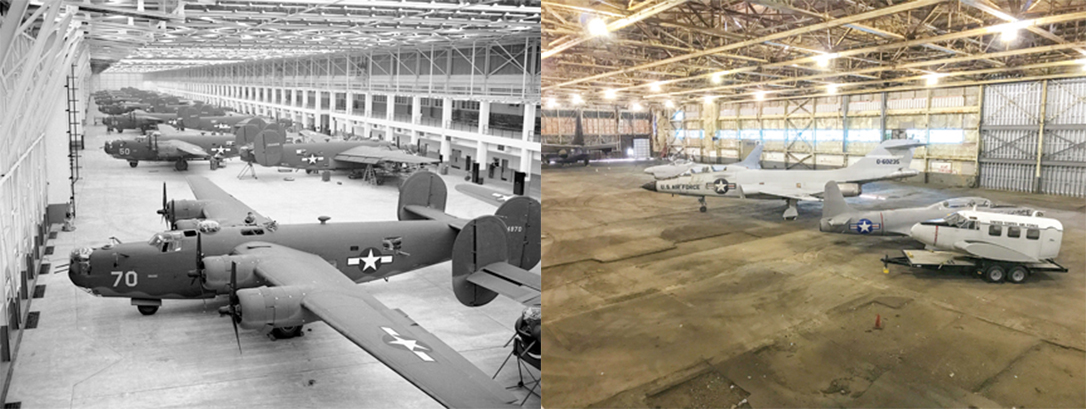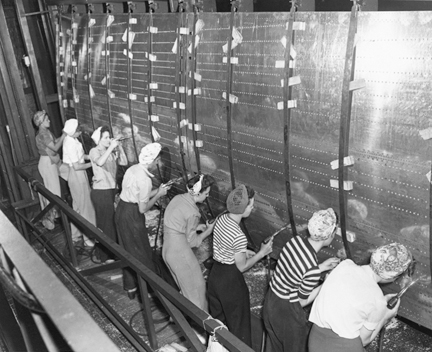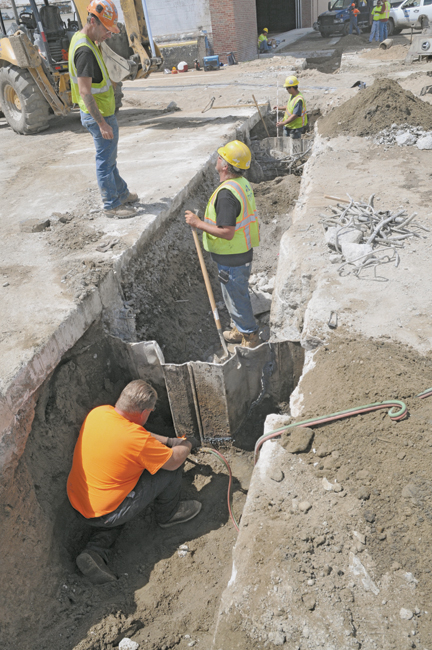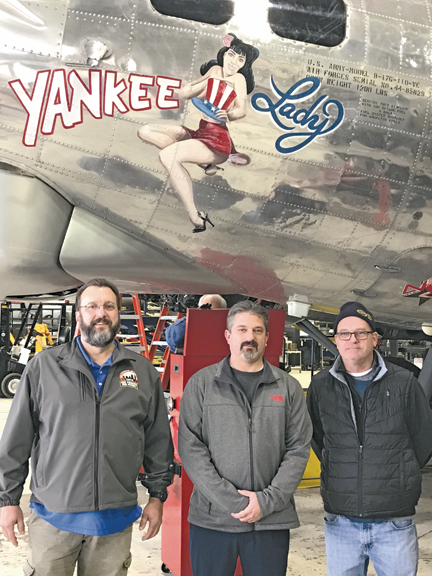W. Jeffrey Koepp is like many baby boomers who grew up in and around the Michigan cities of Ypsilanti and Ann Arbor. He’d long heard tales from older family members who’d worked at the nearby Willow Run Bomber Plant of how the B-24 bombers built there turned the tide of World War II against Germany.

|
The Yankee Air Museum houses the B-24 and other planes used by American forces during World War II. In 1944, the Willow Run Plant that will house the museum was rolling one B-24 bomber off its assembly line every hour.
Credit: Left, Yankee Air Museum. Right, Kevin Perlingo.
|
As vice president of operations of A.F. Smith Electric, an Ypsilanti signatory contractor since 1920, and as a member of Ann Arbor Local 252, Koepp leapt at the chance to preserve that particular piece of his community’s history when the building needed saving.
He’s doing so with the help of other IBEW brothers and sisters and the National Electrical Contractors Association’s Southeastern Michigan chapter. All are volunteering their time and donating money to develop a new Yankee Air Museum on the site of the long-shuttered factory.
“They’ve stepped right up,” said Koepp, a journeyman inside wireman whose family now owns A.F. Smith. “Any time I’ve asked for help, everyone has asked ‘What can we do? What would you like from us?’ Suppliers have donated cable and lamps for temporary lighting. It’s been a group effort from the whole community.”

|
With help from IBEW members, the Yankee Air Museum in Ypsilanti, Mich., will preserve part of the iconic Willow Run B-24 bomber factory, which played a pivotal role in winning WWII and helped create the legend of "Rosie the Riveter."
Photos provided by Yankee Air Museum.
|

|
Female workers at the Willow Run Bomber Plant install the engine inside a B-24 during World War II.
Photo provided by Yankee Air Museum.
|

|
IBEW members and signatory contractor A.F. Smith Electric have donated time and money to the museum.
Credit: Kevin Perlingo
|

|
| From left, Ann Arbor, Mich., Local 252 business agent Rick Plisko, Business Manager Ryan Husse and assistant business manager Dave Bianco during a recent visit to the Yankee Air Museum.
|
Koepp’s grandmother and grandfather worked at Willow Run, which was built by the Ford Motor Co. and opened in the summer of 1942. Henry Ford had retired as the company’s chairman, but still had a major say in its direction. He insisted it refuse public funding for the plant and instead, build it itself and sell it to the federal government. The company then leased it back for the rest of the war.
The massive facility – it had about 3.5 million square feet of factory space – was built without pillars in many sections so it could house an assembly line more than 1 mile long and wide enough to allow planes to roll off it. Designed by architect Albert Kahn, it was believed to be the largest factory in the world under one roof at the time.
By 1944, workers were rolling out one B-24 every 55 minutes, 24 hours a day, seven days per week. Some historians believe the term Rosie the Riveter, used to honor the women who stepped up to handle the traditionally male factory jobs during World War II, originated at Willow Run in honor of Rose Will Monroe, a worker inside the plant.
“Without the Willow Run bomber plant, we would not have won the war,” said Dennis Norton, the Yankee Air Museum’s co-founder, whose mother worked at Willow Run. “We had to destroy Germany’s industrial might in Europe before sending troops in there and that’s what the B-24 did.”
After the Allies’ victory, Ford declined to exercise its option to purchase the plant and it eventually was sold to the Kaiser-Frazer Corporation, which produced cars and the C-119 Flying Boxcar there.
After years of losses, the company moved its operations to Toledo, Ohio. General Motors Co., Ford’s chief rival at the time, began leasing the facility in 1953 and eventually purchased it. Kaiser-Frazer eventually became Kaiser Motors before ceasing operations completely in 1955.
GM’s last car rolled off the line at Willow Run in 1992. The company’s powertrain plant closed in 2010, marking the end of GM’s operations there. Most of the plant was demolished by 2015.
The Yankee Air Museum, which Norton and others founded in 1981 to celebrate the area’s rich aviation history, was looking for a new home after its original facility was destroyed by a fire. They reached an agreement with the trust that owns the property to purchase and renovate a small part of the plant and house the museum there. They’ve been fundraising and getting help from volunteers in the community ever since.
That’s where Koepp and the IBEW along with NECA came in. He knew about his family’s history there. His grandfather went on to become a licensed pilot and took young Jeff on flights out of adjoining Willow Run Airport and Ann Arbor Airport as a child.
A.F. Smith was one of the signatory contractors used during the demolition, where Koepp had a chance to meet Norton and learned about some of the critical needs for the museum. One of those was arranging temporary power in the small part of the plant still standing.
Koepp found an old pump house about 1,000 feet away that was capable of generating 480 volts. In 2015, Local 252 members donated about $25,000 worth of labor to connect it with the museum, allowing renovations to begin.
A.F. Smith supplied an 800 amp main distribution panel, four 225 amp lighting panes, four 75 kva transformers and four 225 amp branch power panels to power the temporary lighting.
“That was a big, big job,” Norton said. “We had no transformers and no connection. Lines had to be strung to put up temporary lights just so we could operate.”
Local 252 Business Manager Ryan Husse said renovating the museum doesn’t just honor the aviation history there. It also honors the IBEW’s and Local 252’s history. Wiremen were employed as electricians at Willow Run throughout GM’s ownership of it.
“That place paid a lot of bills for our members,” said Husse, noting that most of Local 252’s volunteer work began under his predecessor, Tim Hutchins, who is now on the Sixth District staff, as well as former longtime Business Manager Greg Stephens and now-retired Sixth District International Representative John Briston.
Dave Bianco, Local 252’s assistant business manager and a longtime business representative, said GM would install a new electrical system whenever it decided to change the model of the automobiles it was producing at the plant.
That work was done by both Local 252 members – many of whom lived in the adjoining West Willow community alongside members of the United Auto Workers – and travelers from across the country.
“We always had a signatory [contractor] in there,” Bianco said. “It put a lot of people to work.”
Koepp said suppliers have stepped up to donate cable and lighting. Local 252 members have installed it, much of it on a volunteer basis. He arranged a deal with Square D, a company that manufacturers switch gear, to have a switchboard delivered in just 13 weeks – about half the usual time, and Square D donatied half the cost. That result was a 3,000-AMP main electrical switchboard at a bargain price.
Local 252 has committed to donating at least $25,000 in labor this year, which is a critical one for the museum. That’s because a new, more immediate challenge has surfaced.
Willow Run Airport officials informed the museum in mid-2018 that it could no longer use the hangar in which it allowed it to store its planes, which include a B-17, B-25 and C-47, because it needed the space for its own operations. Many of the aircraft remain in use and public flights are available.
Museum officials must vacate the hangar by the end of this year. A drive to raise an additional $6 million to build a new hangar to store the historic planes is ongoing. Donations can be made at savethebomberplant.org.
“This was a major blow,” Koepp said. “That really changed things up on us. We’ve got to come up with a place to store and move these flyables to.”
Local 252 has led the way for the IBEW, but it hasn’t been alone. Detroit Local 58 and other local unions in the state also have pitched in to help. Work is expected to continue on the museum for the next several years. More information is available at yankeeairmuseum.org.
Norton said he’s grateful for the help of the IBEW and other unions in the area. Without them, preserving a critical part of the nation’s World War II history would have been difficult.
“There’s been nothing like Willow Run before or since,” he said.